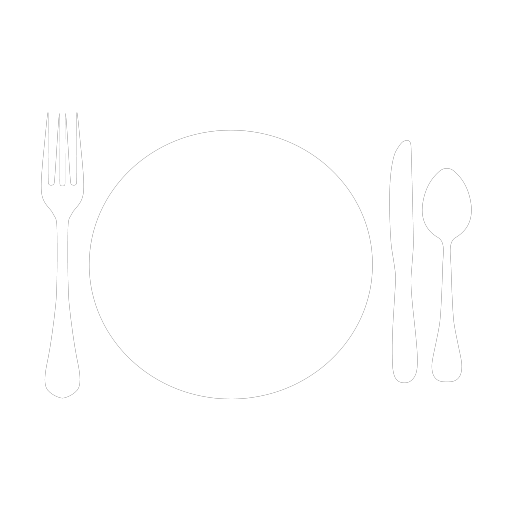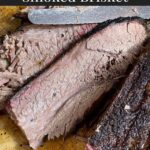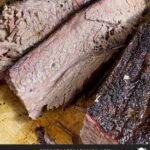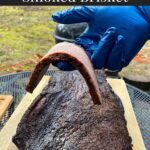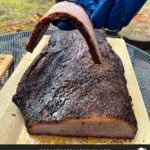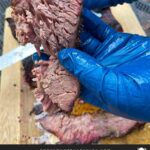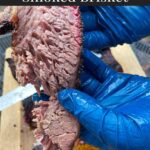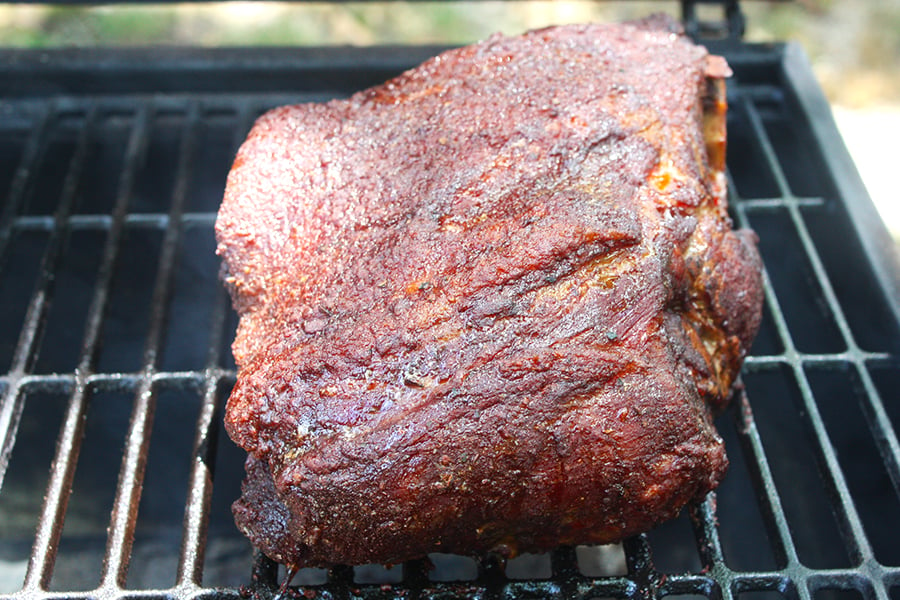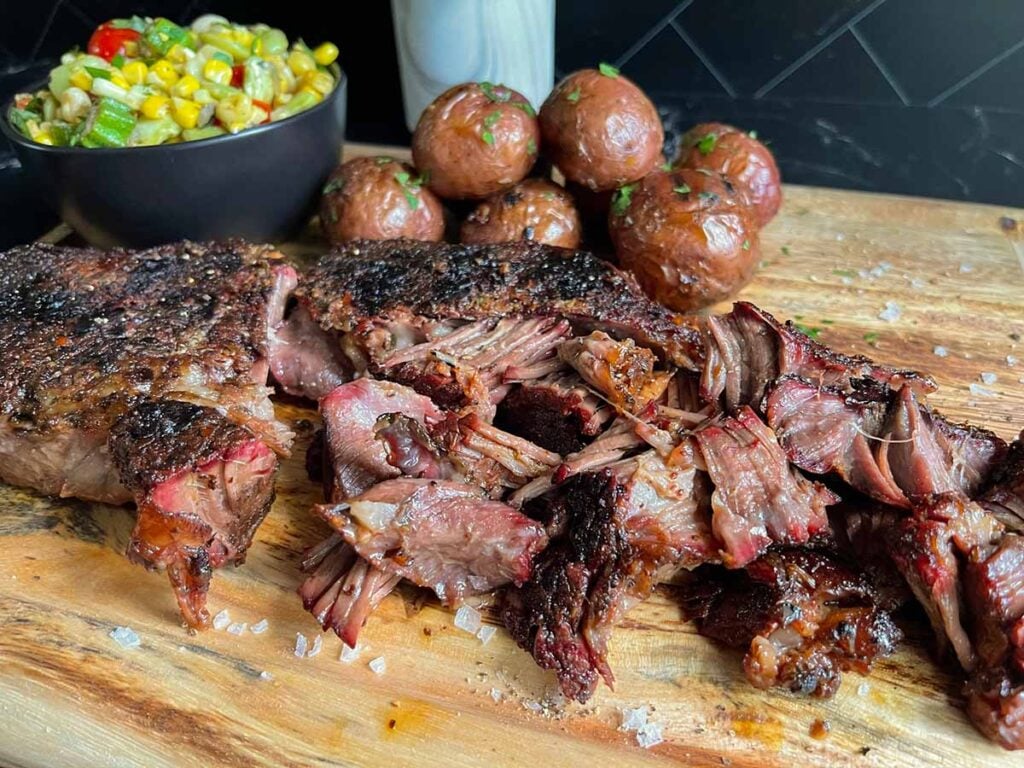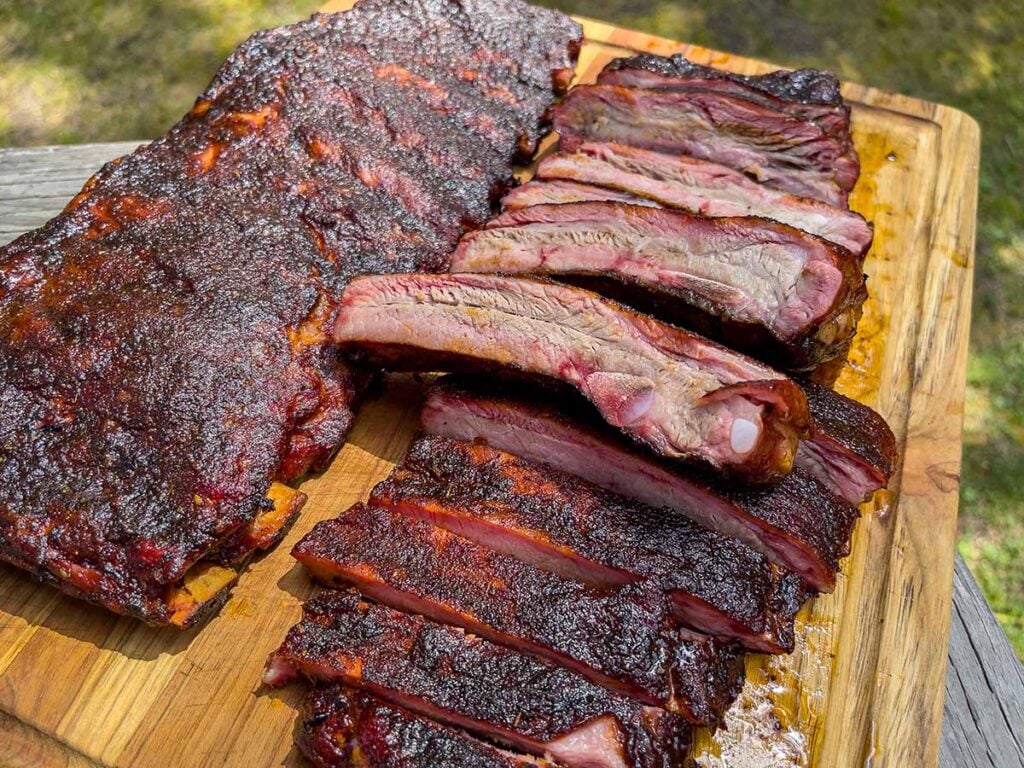Central Texas Style Smoked Brisket
We’re diving into the smoky, savory world of Central Texas style backyard smoked brisket. Whether you’re a seasoned pitmaster or a curious beginner, get ready to embark on a mouth-watering journey that promises to transform your backyard into a haven of authentic Texas barbecue.
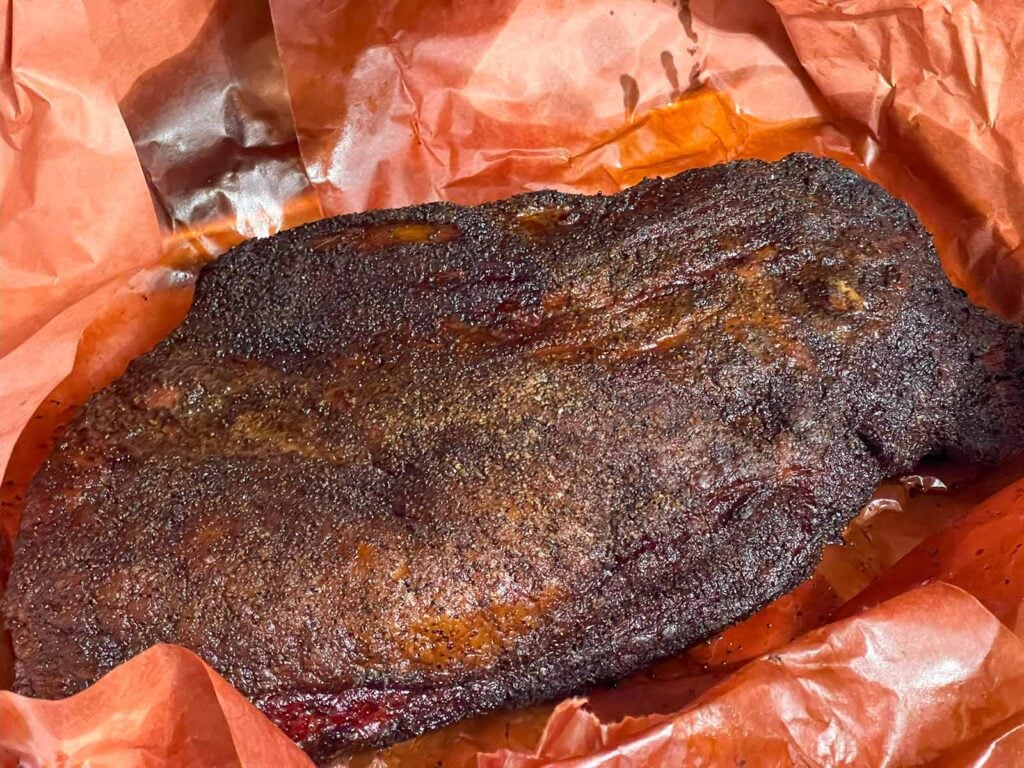
Why You Will Love This Recipe
This post is all about Texas-style backyard BBQ brisket. While some may feel a bit intimidated by smoking, what is arguably the crown jewel of BBQ, I promise it’s not hard.
So, no brown sugar, no barbecue sauce, just a whole packer brisket, kosher salt, coarse black pepper, and a bit of garlic powder.
We will be using a packer-cut brisket, which means it has both the flat and the point, a whole brisket. Even as I write this, I am thinking about the leftovers, and how I am going to use them! 🙂 Brisket tacos, brisket chili, brisket hash … oh, hell yeah!
If you follow a few simple steps and smoke it low and slow, you will achieve backyard BBQ knighthood by serving up the best tasting brisket you ever had.
And yes, you can do this in a pellet smoker, offset smoker, gravity fed smoker, pretty much any kind of smoker. I don’t think I would try it in a Weber, though.
Ingredients Needed
Nothing to it. Equal parts coarse black pepper, kosher salt, a little garlic powder, and a big ole chuck of beef!
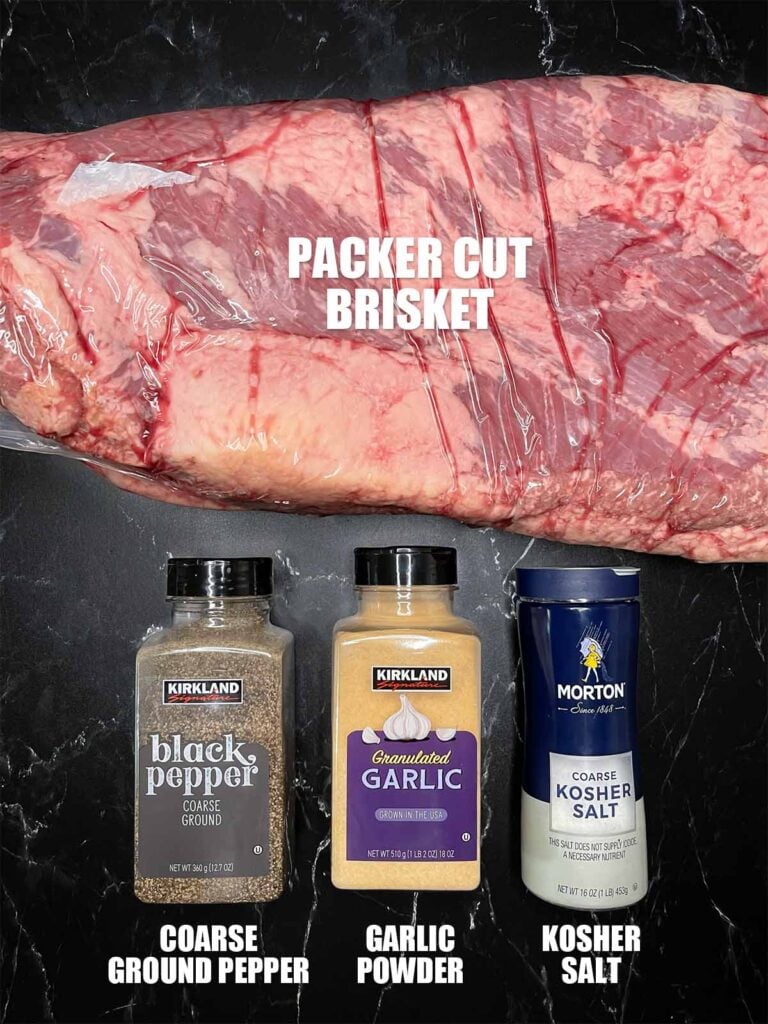
About Backyard Barbeque Brisket
Before we start trimming, here are some thoughts. There are basically three ways of trimming the brisket.
A competition trim would be all about that perfect box presented to the judge. The trimming is very aggressive and exacting just to land a few good bites.
A restaurant-style trim is also pretty aggressive, removing a fair amount of material as they will use the trimmings for other things, such as sausage and burger meat. They also want uniform cook times and serving sizes.
That leaves the backyard BBQ’er, such as myself … and you, more than likely.
We don’t have to be exacting, nor do we want to toss things idly away. We want to maximize our barbeque yield because, quite honestly, a brisket is not a cheap piece of meat, and it takes time to crank one out.
Don’t Sweat The Recipe is supported by its readers. We may earn a commission if you purchase through a link on our site. Learn more.
We will be trimming our brisket this way. There are some areas to focus on, but don’t lose yourself going for that immaculate trim; it’ll be fine.
How To Trim A Packer Cut Brisket
Remove the brisket from its wrapper, dab it dry with some paper towels, and set it down meat side up. Locate that big chuck of hard fat, also known as the deckle.
Using a sharp knife (I am using my Wusthof 6″ boning knife), begin to remove it by making thin cuts, removing bits at a time. We want to cut it all away until you can feel that the remaining fat is no longer firm but gives when you press down with your fingers.
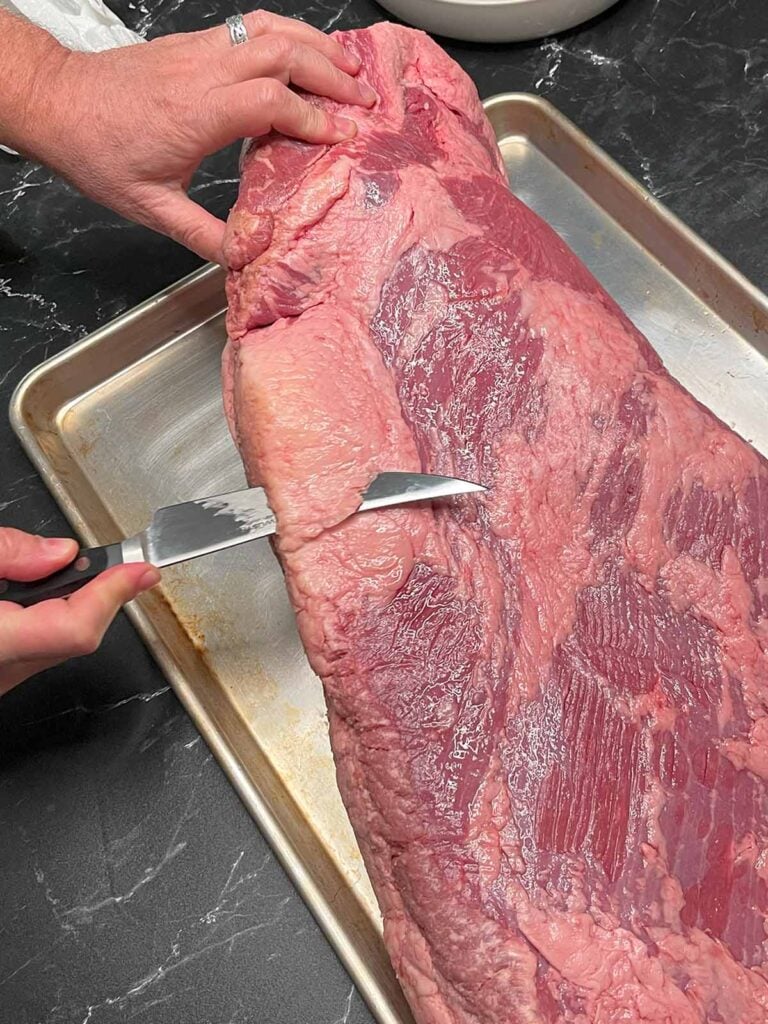
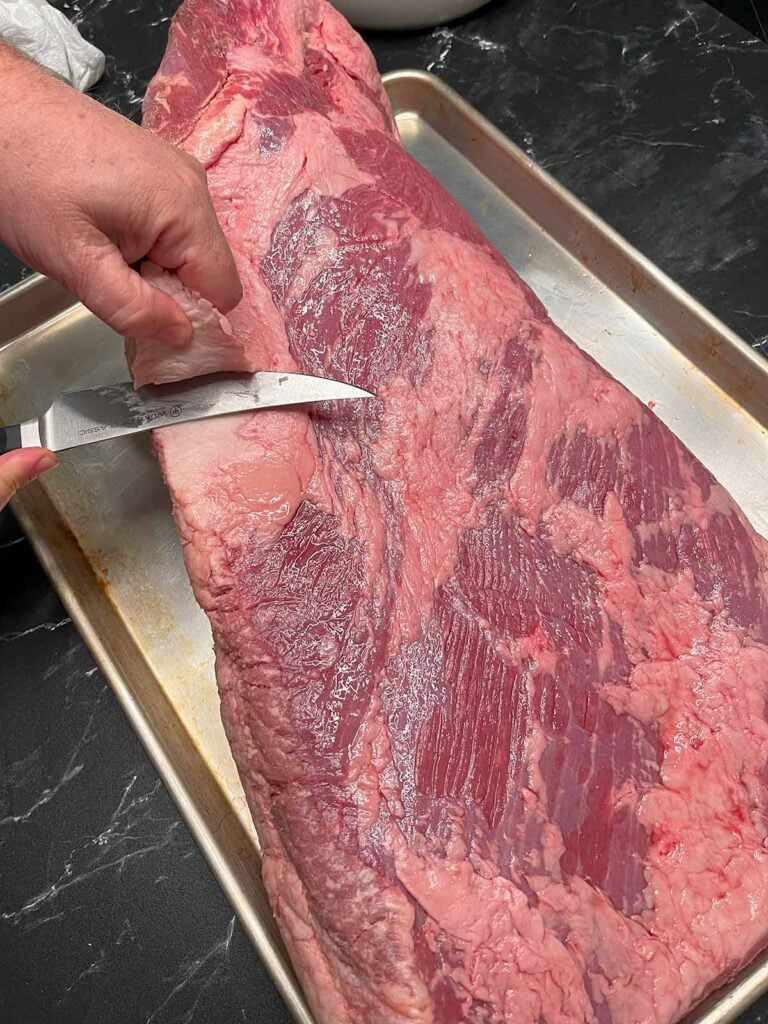
This fat will not render down, so it needs to go! Keep rubbing the area with your fingers, testing for that fat layer to be thin enough that it yields.
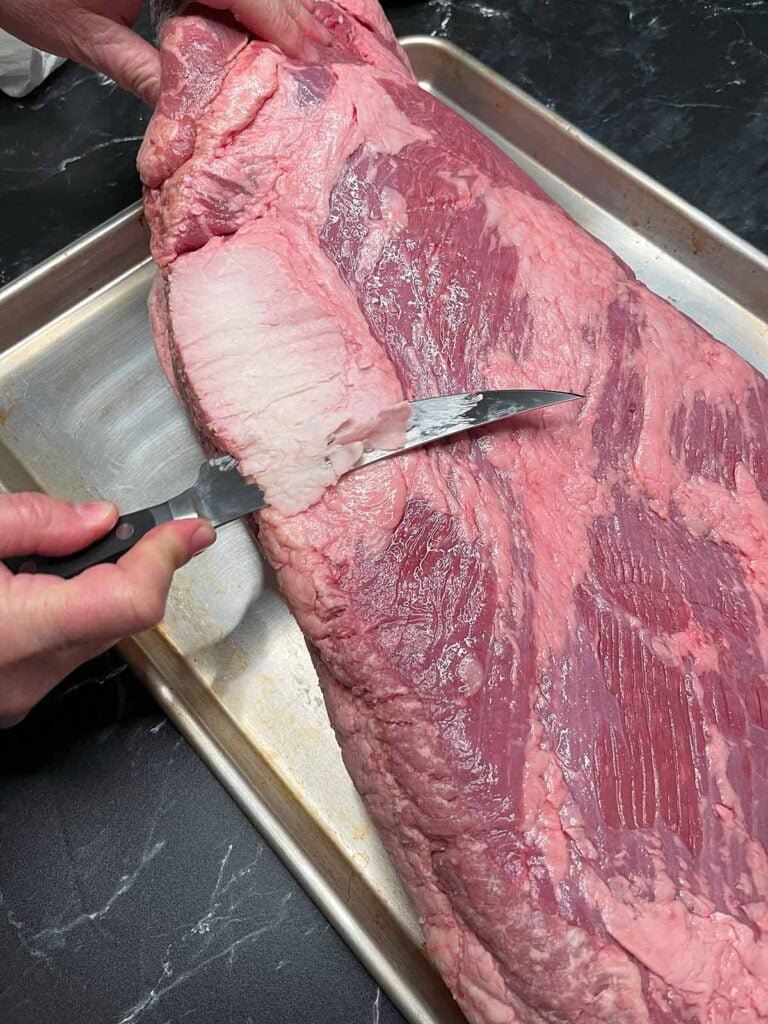
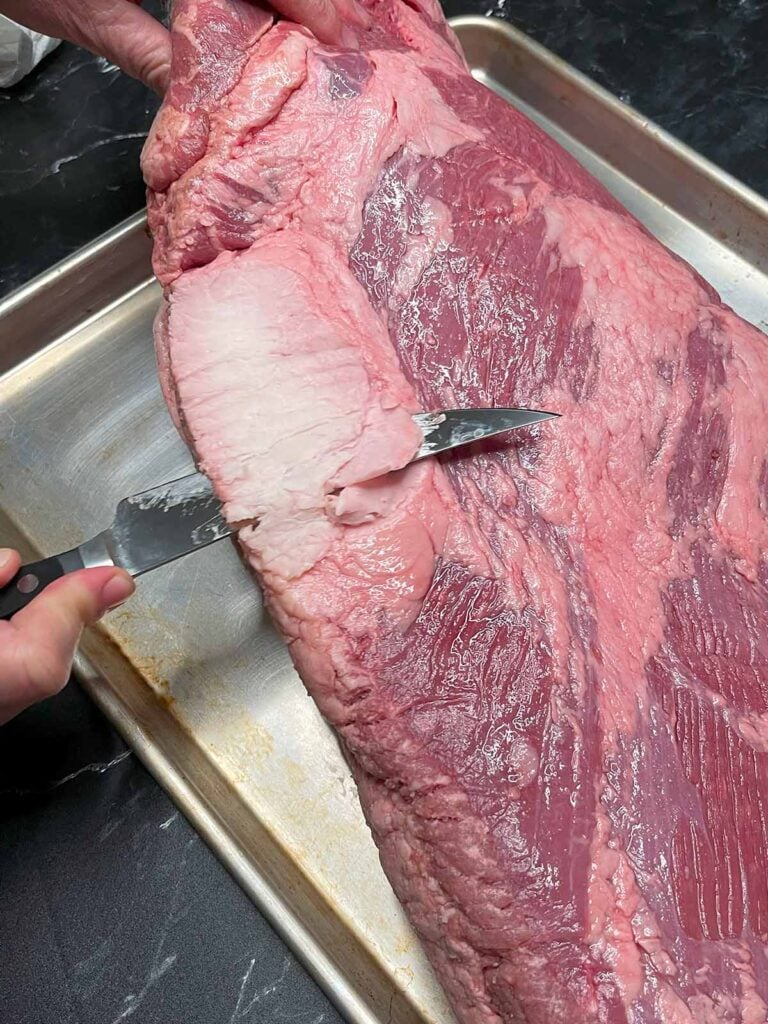
Once you have removed that, continue to trim the meat side of the brisket, cutting away any larger pieces of fat that you see or can feel with your fingers.
Next, locate the rough edge of the brisket. Go ahead and trim that off. The cut doesn’t have to be thick. We just want to clean up that edge.
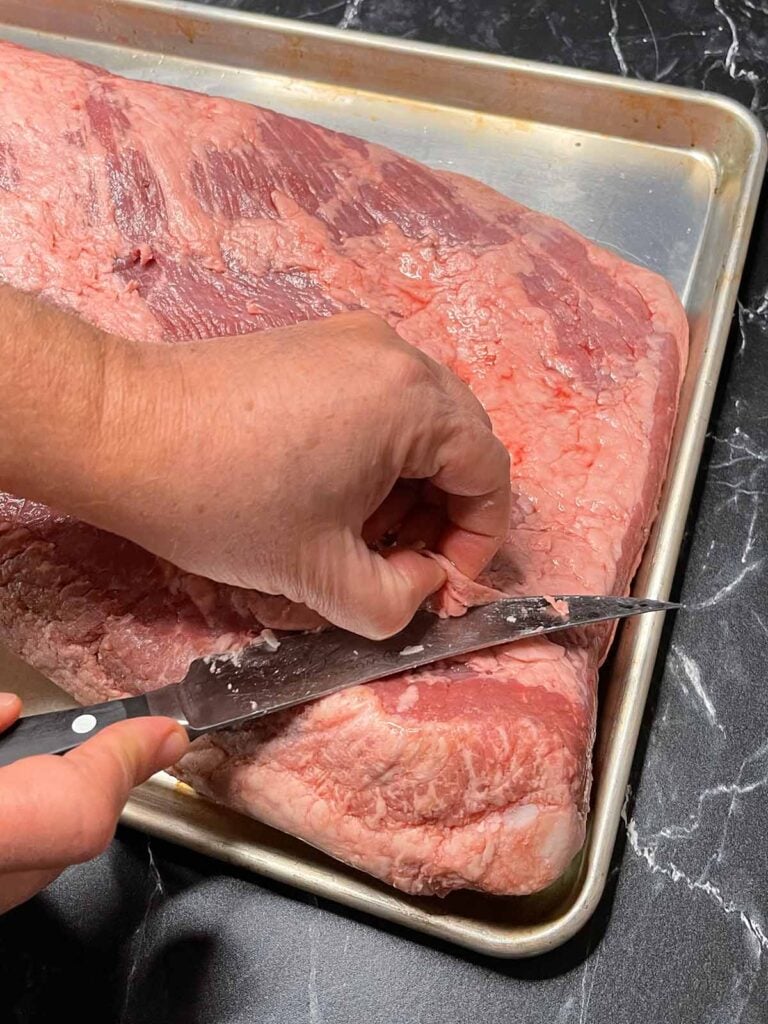
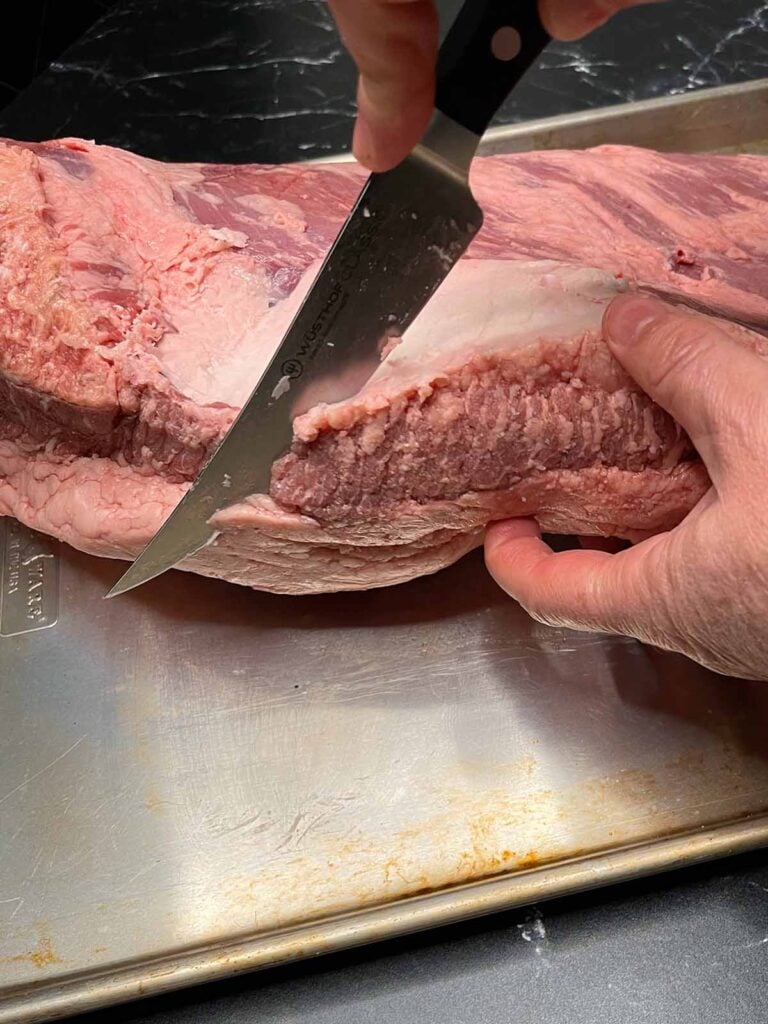
Continue to basically massage the brisket with your fingers, looking for hard areas of fat. As you find them, very carefully slice away the fat until that area yields to your fingers and is no longer hard without removing ALL the fat.
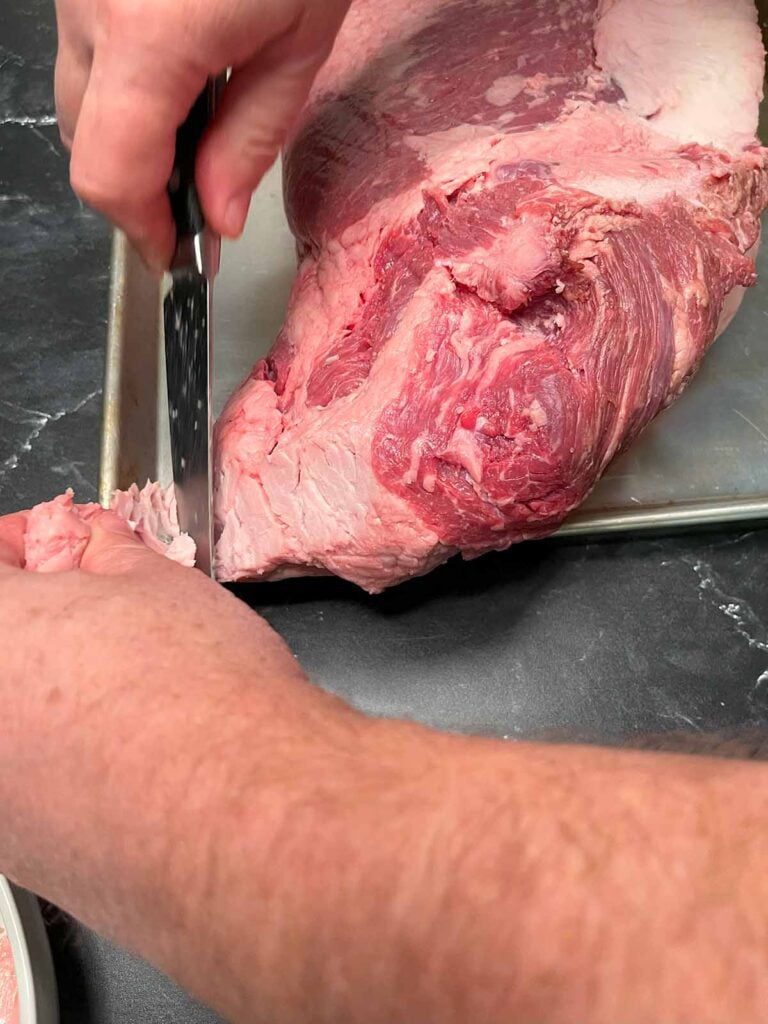
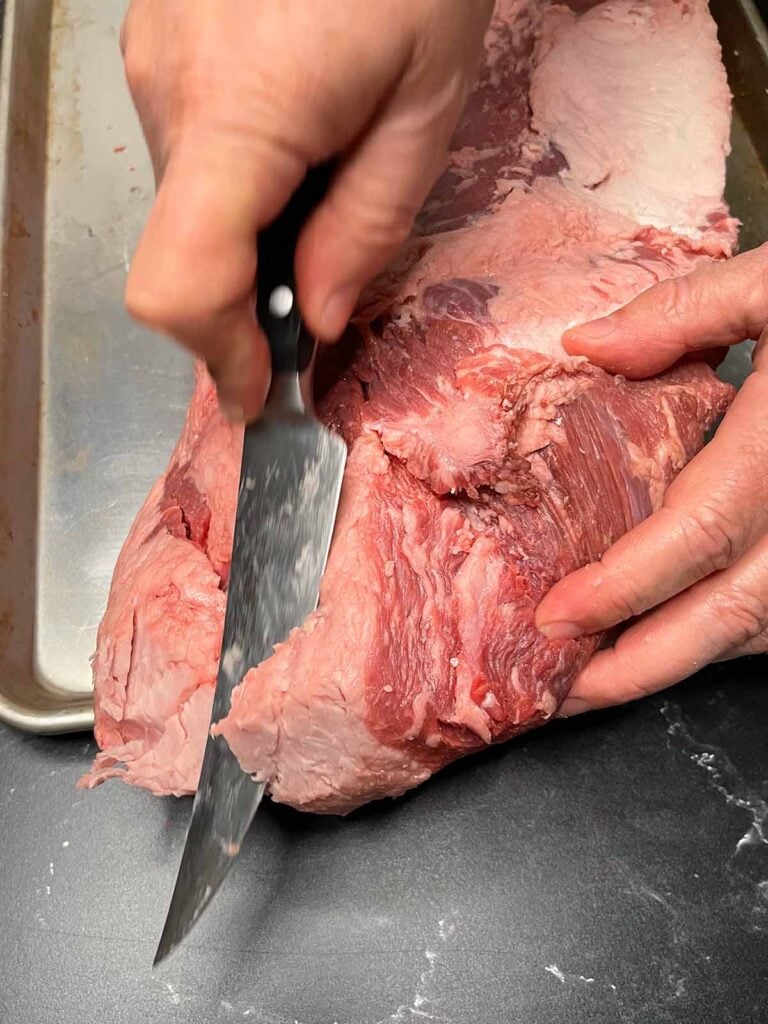
When you are satisfied with that side, it’s time to flip it on over to do the same thing. I recommend trimming the fat to 1/4 inch. Take a look at the brisket, find the areas that are thickest, and repeat the process, slowly shaving the fat off.
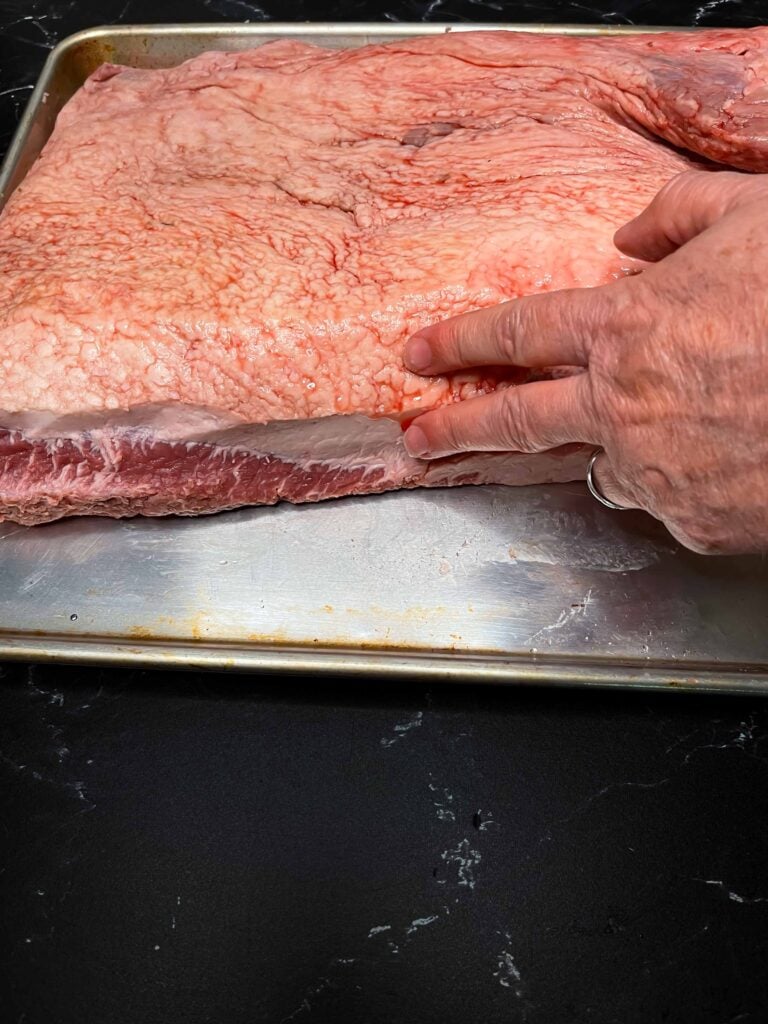
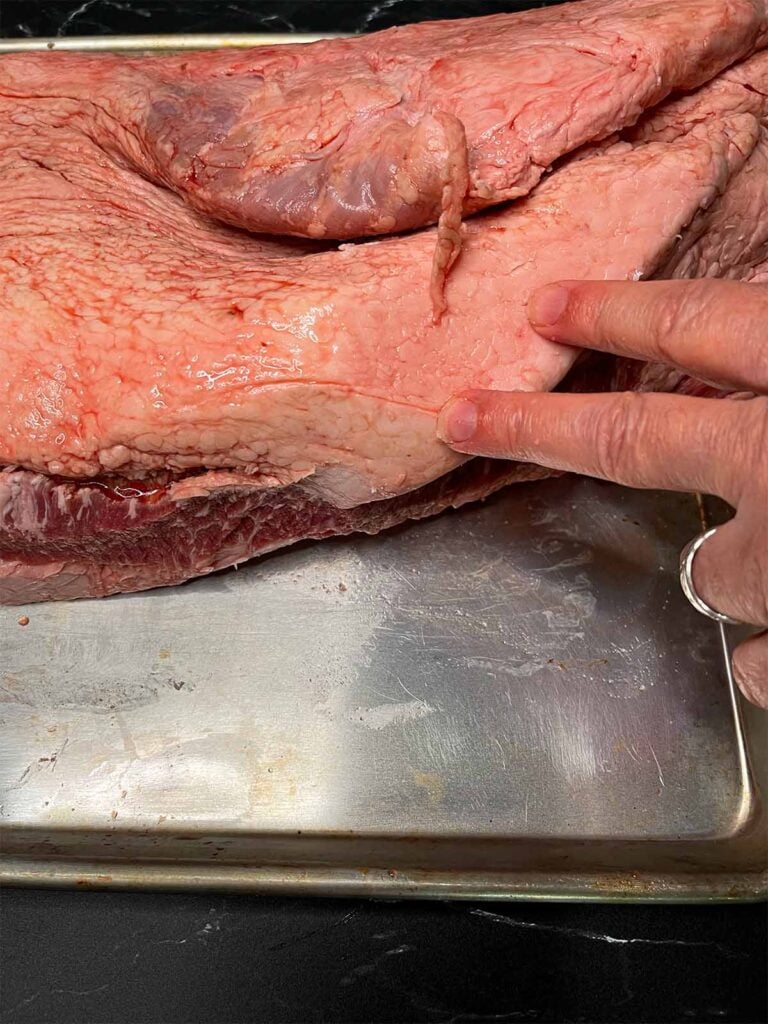
Keep going across the brisket, carefully removing fat as you find it. Continue to trim until the fat feels soft under your fingers, roughly leaving 1/4 inch of fat in the thickest areas.
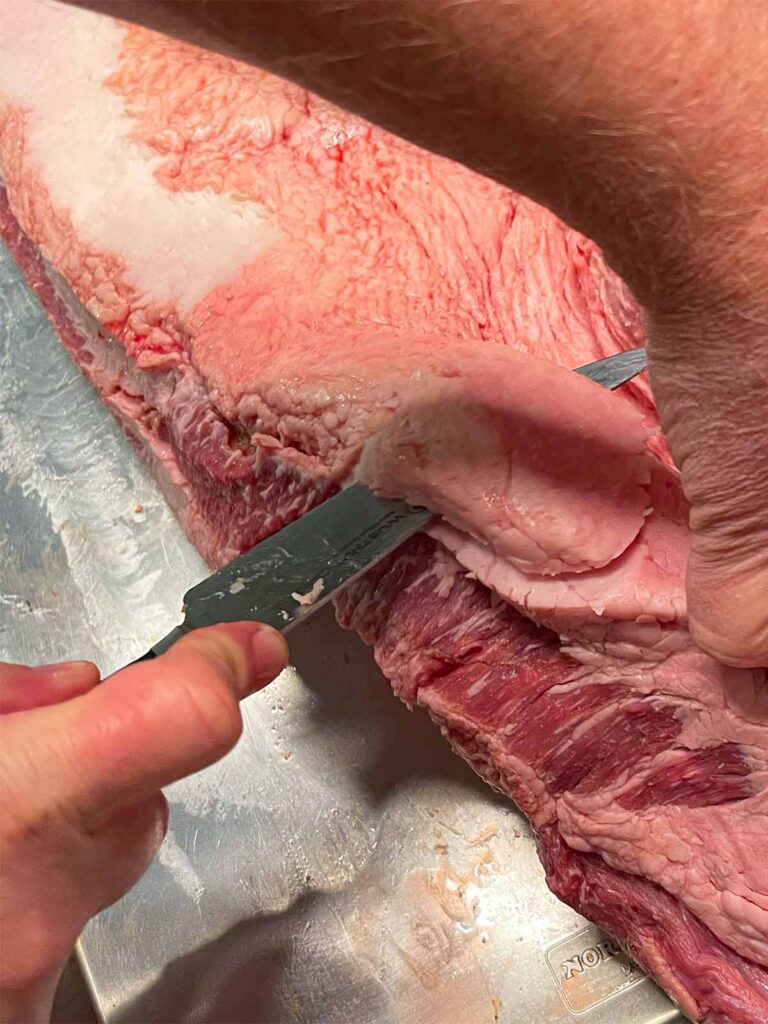
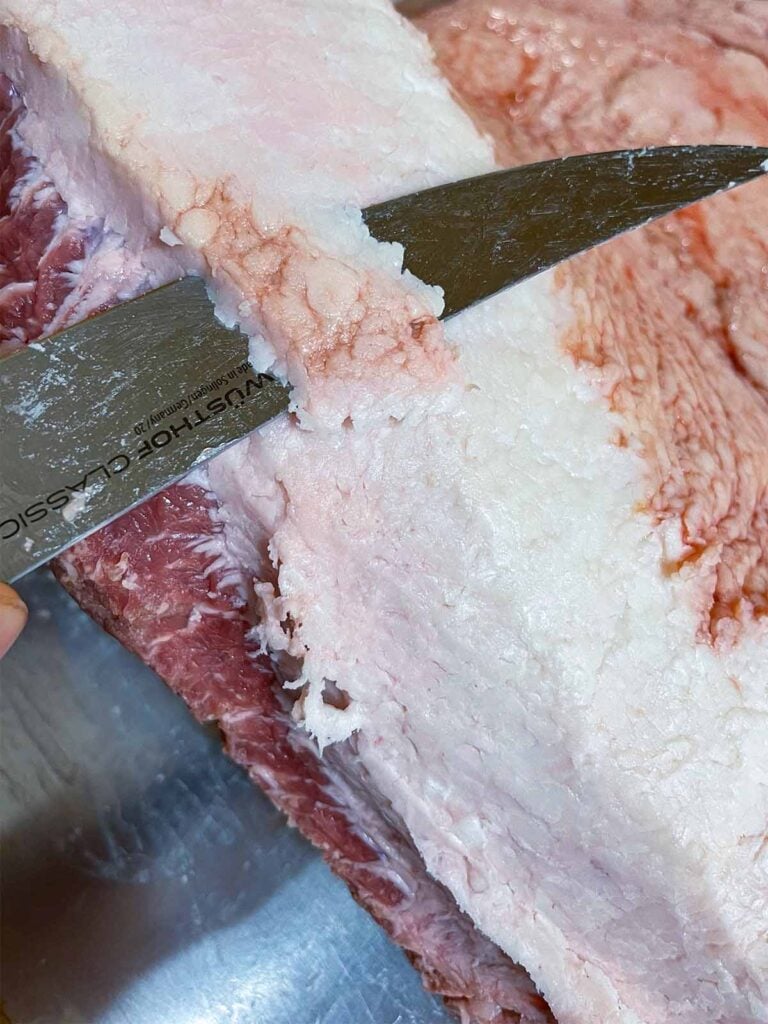
When you’re finally happy with the fat removal, locate that end of the brisket on the flat that is really thin and just trim that off. It will burn up during the smoking process.
You can add that to your scraps (for ground) or just toss it. Don’t worry. You’re still gonna have plenty to eat! In the end, you should have a nicely trimmed brisket ready to get rubbed down.
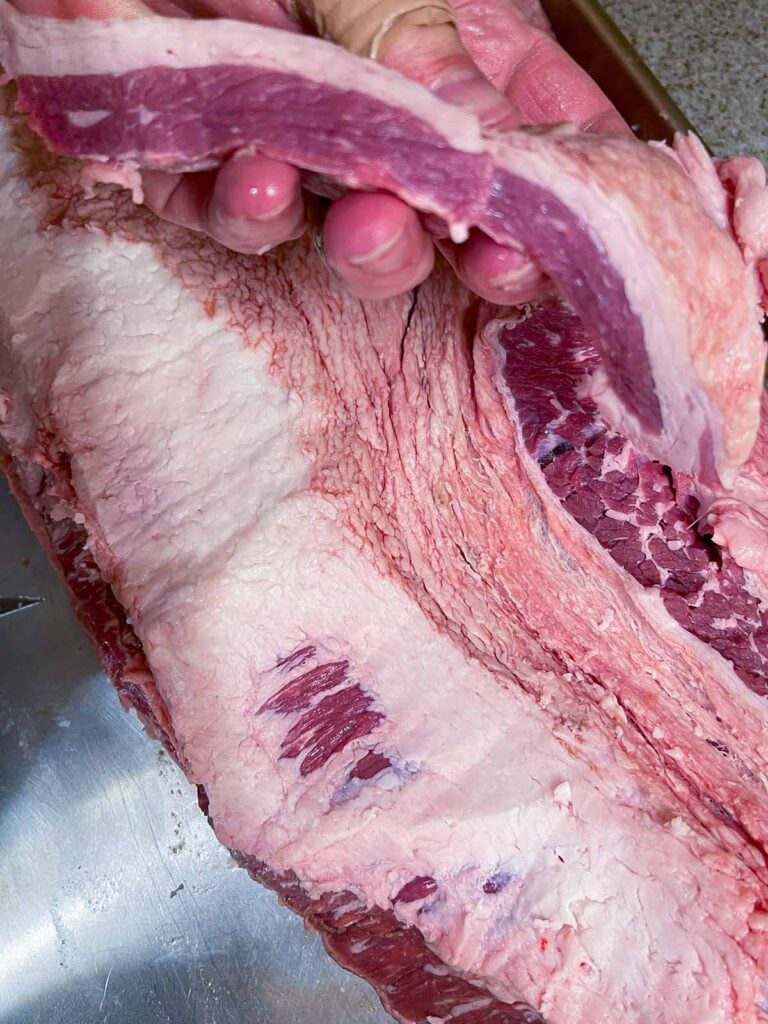
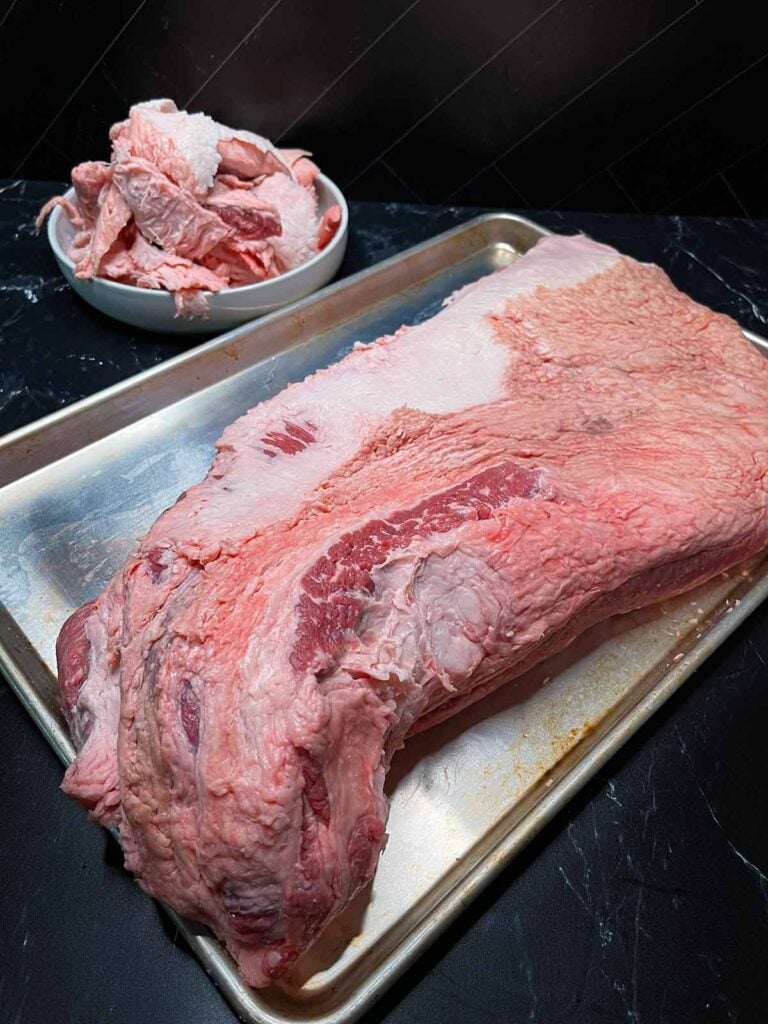
Congrats! You just did the hard part of smoking a brisket, the trim. The rest is just time and temp.
As we’re doing a central Texas brisket, I am keeping with a 50/50 mix of kosher salt and coarse ground pepper. I did add some garlic powder as well, but Central Texas BBQ joints do that as well, so it’s still proper!
We definitely want that fat side up when smoking, so start with the meat side up and apply a generous amount of the rub. Flip it over so the fat side is up, and apply generously as well.
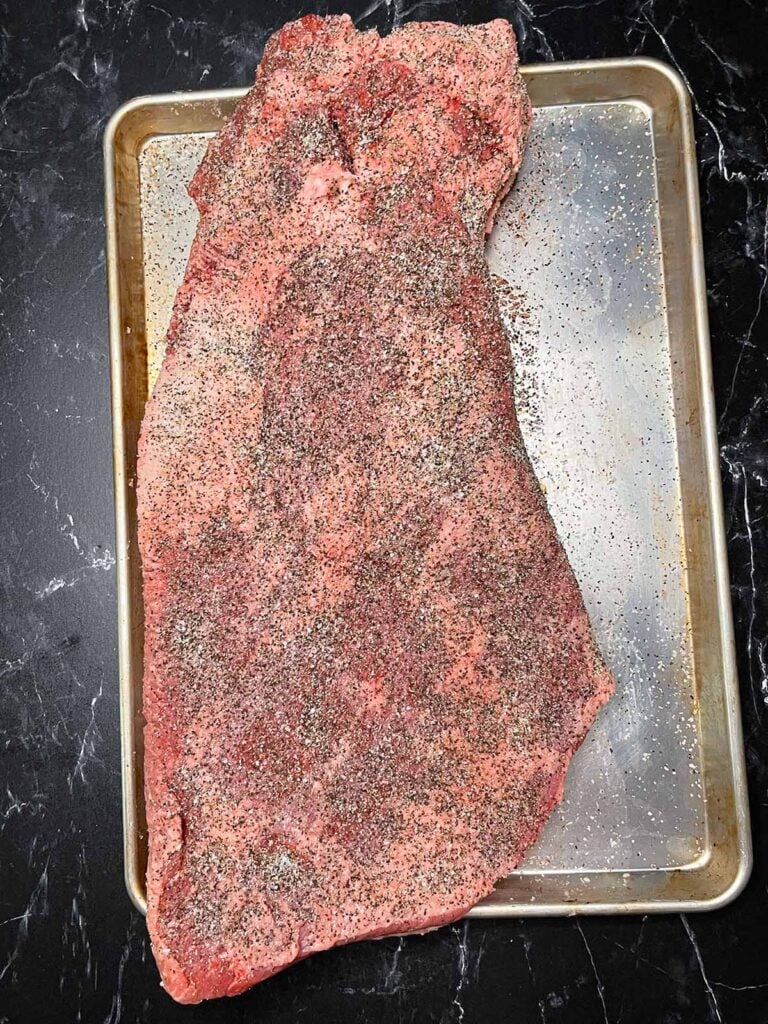
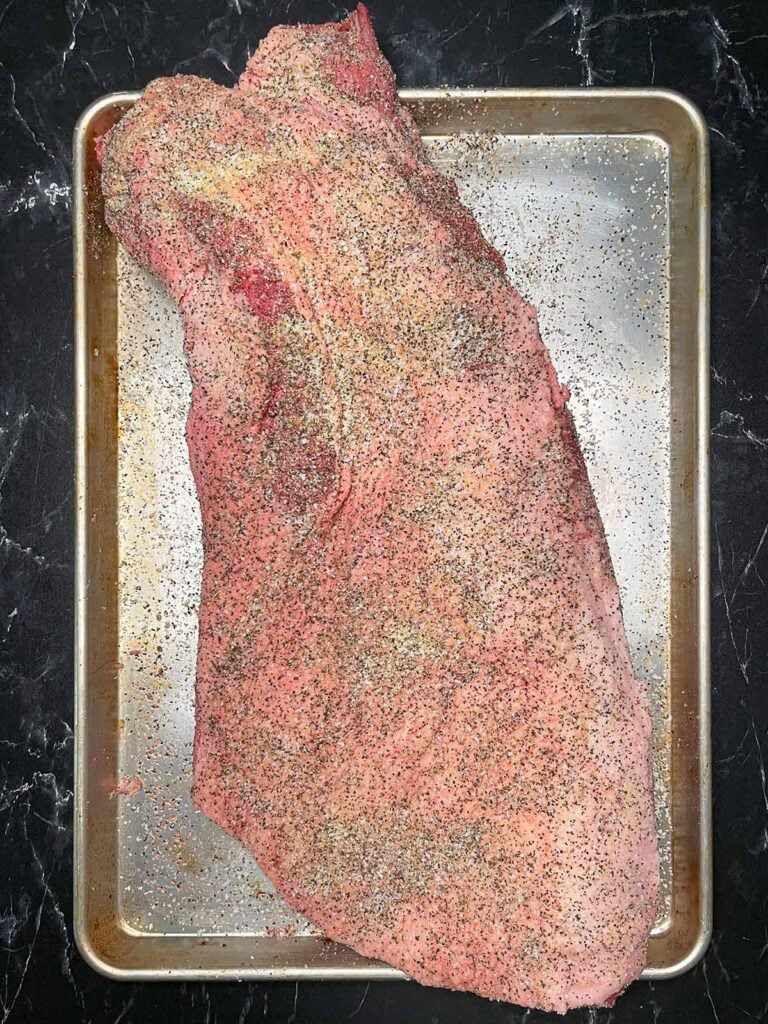
With that done, you’re ready to smoke. In a perfect world, you would like to leave this out for a couple of hours before getting it to room temperature. But it’s not that important in the end. Let’s get smoking!
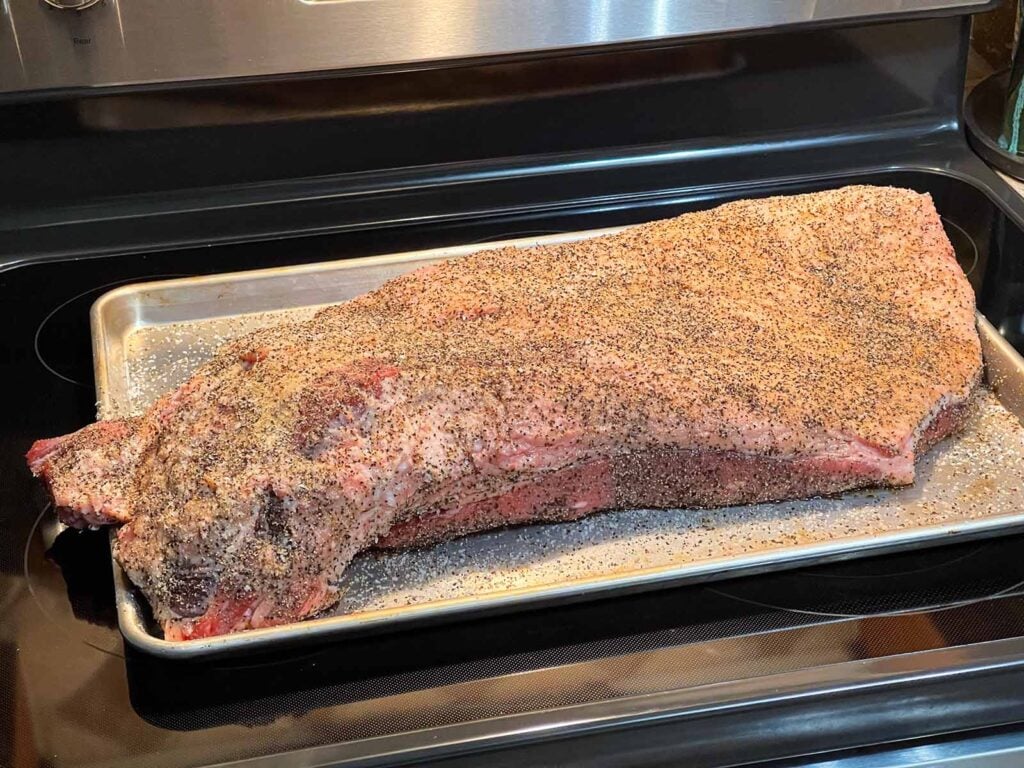
How To Smoke A Packer Cut Brisket
This is a low and slow, Texas-style technique. I am smoking the brisket at 225 the entire time using post oak. Feel free to use whatever wood is your favorite. Hickory and pecan wood are also good options.
Get the smoker to 225 and place the brisket in, the point side facing the heat source.
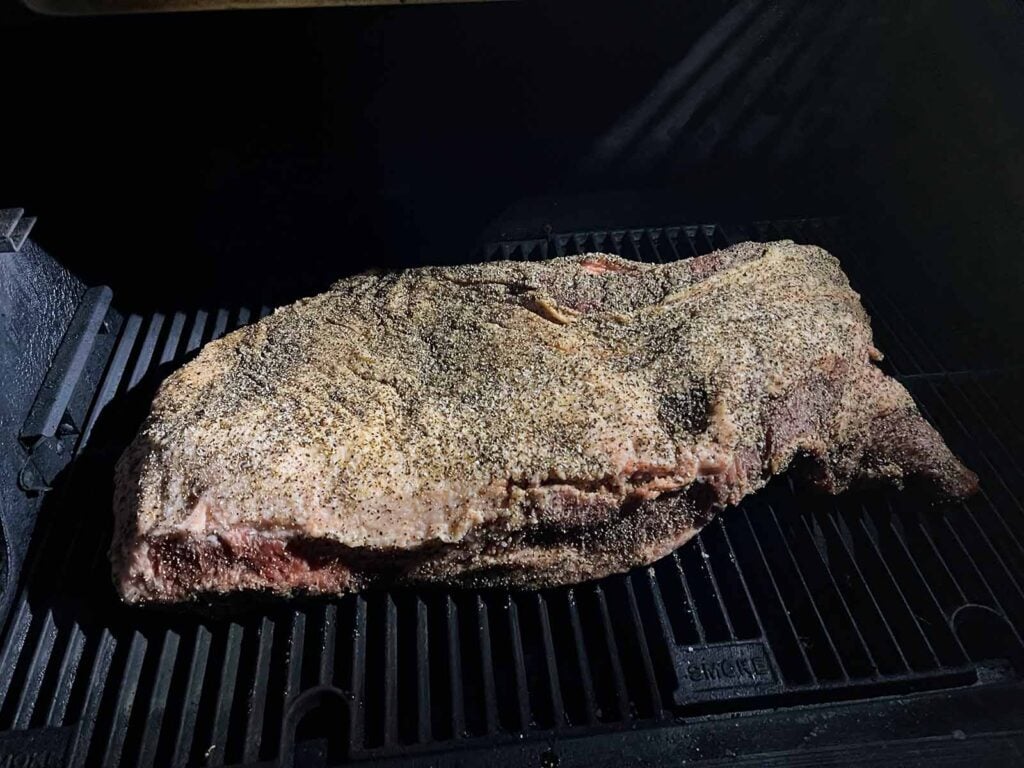
Smoke until the brisket reaches an internal temperature of approximately 165 degrees Fahrenheit.
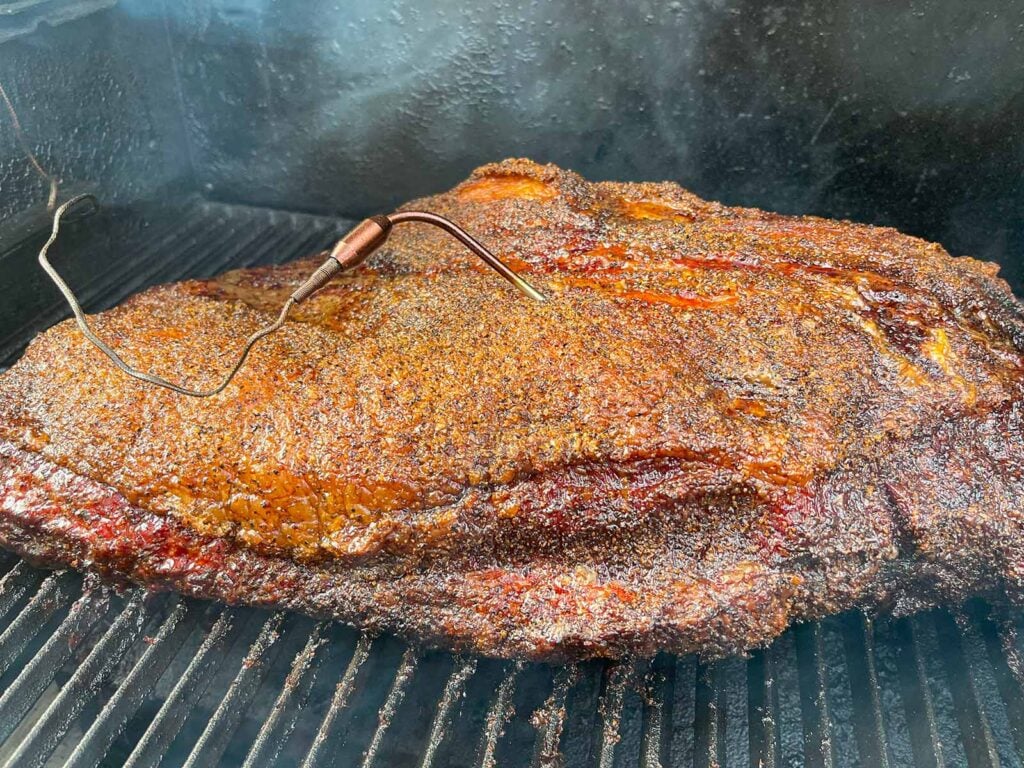
Remove and wrap the brisket in unwaxed peach butcher paper (don’t use aluminum foil) and place it back onto the smoker. Ensure that when you wrap it, the fat side remains in the up position.
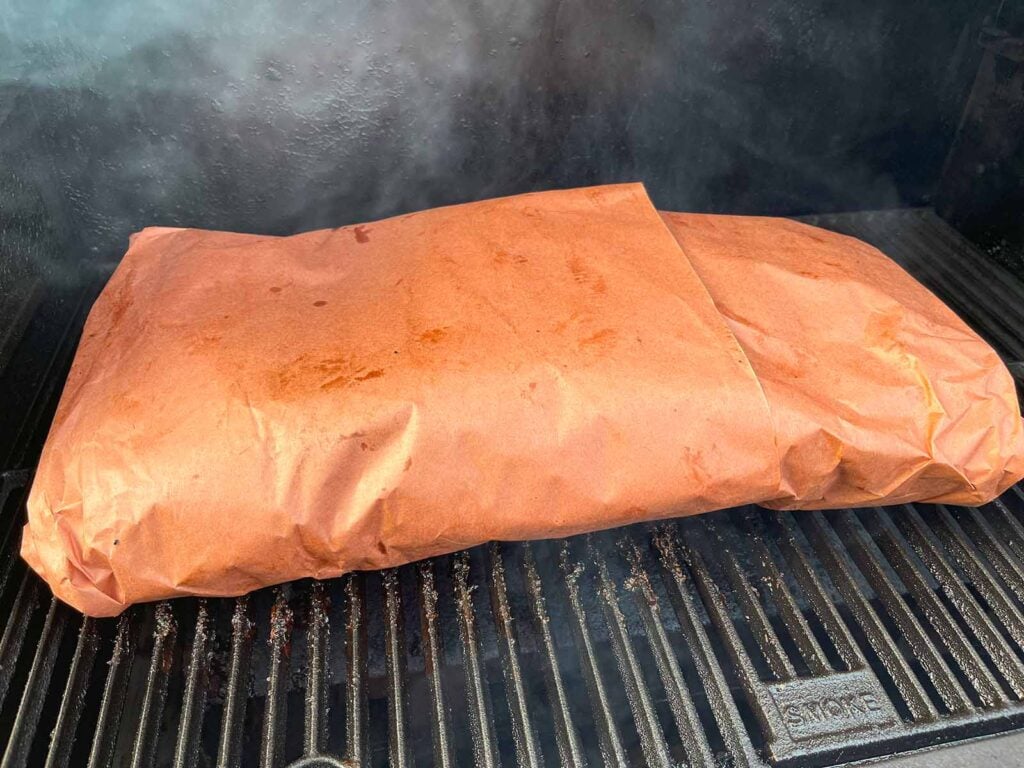
Continue until the internal temperature hits somewhere close to 203 degrees Fahrenheit and remove. Use an instant-read thermometer, if you have one. If you don’t have one, get one!
If you plan on eating later, wrap it in a towel and place it in a cooler. I have a cooler set aside for BBQ for this reason. It will keep warm for hours.
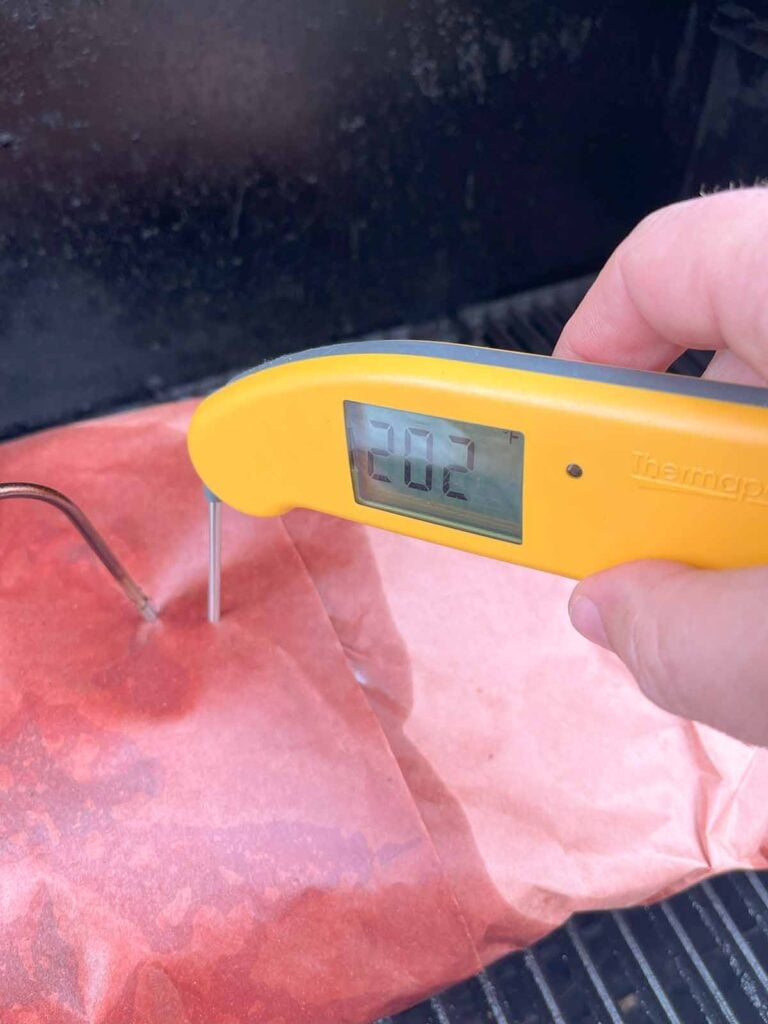
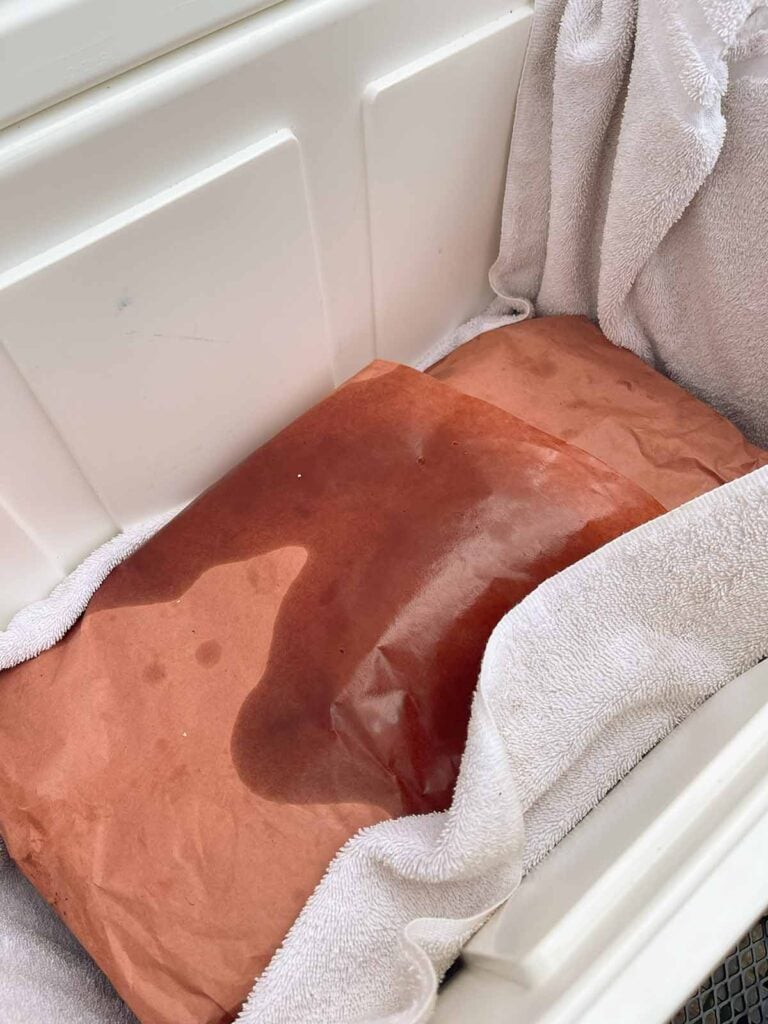
You do need the brisket to rest for at least 90 minutes before cutting.
When you’re ready to cut, open up the butcher paper and take a look at that beautiful brisket!

Place the brisket on a large cutting board and start cutting! For the flat side, you want to cut slices about a pencil width wide. Cut against the grain.
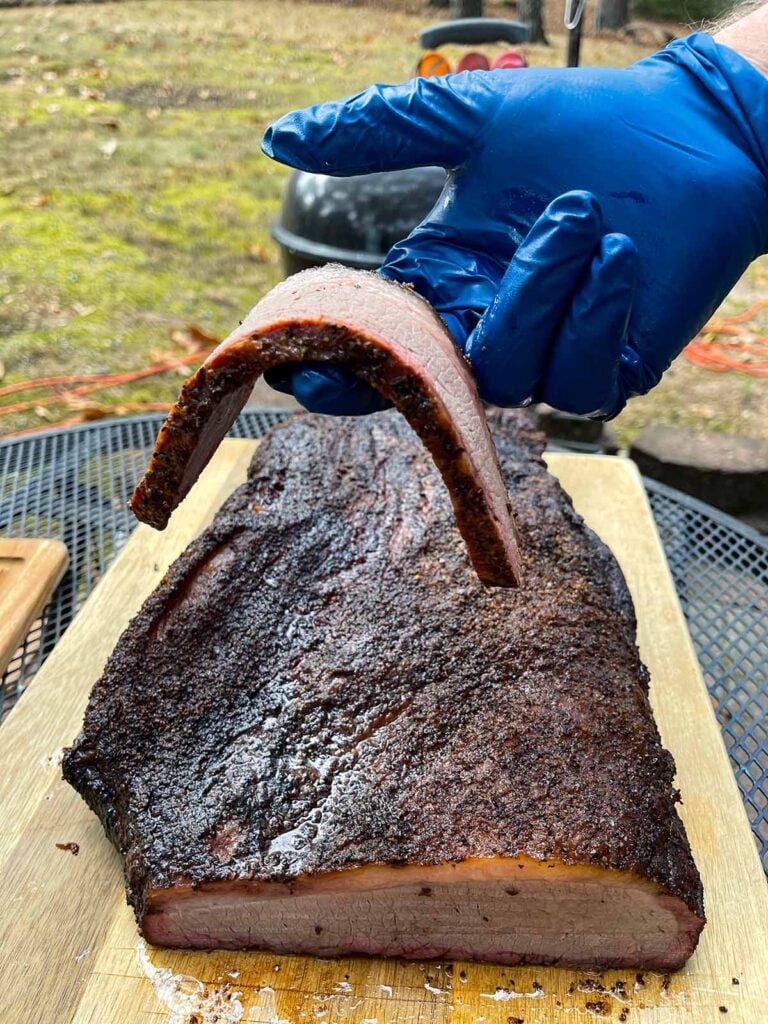
For the point side, turn the cutting board 90 degrees and cut your slices a little thicker as there is more fat in this part, and more tender. Again, you’re cutting against the grain.
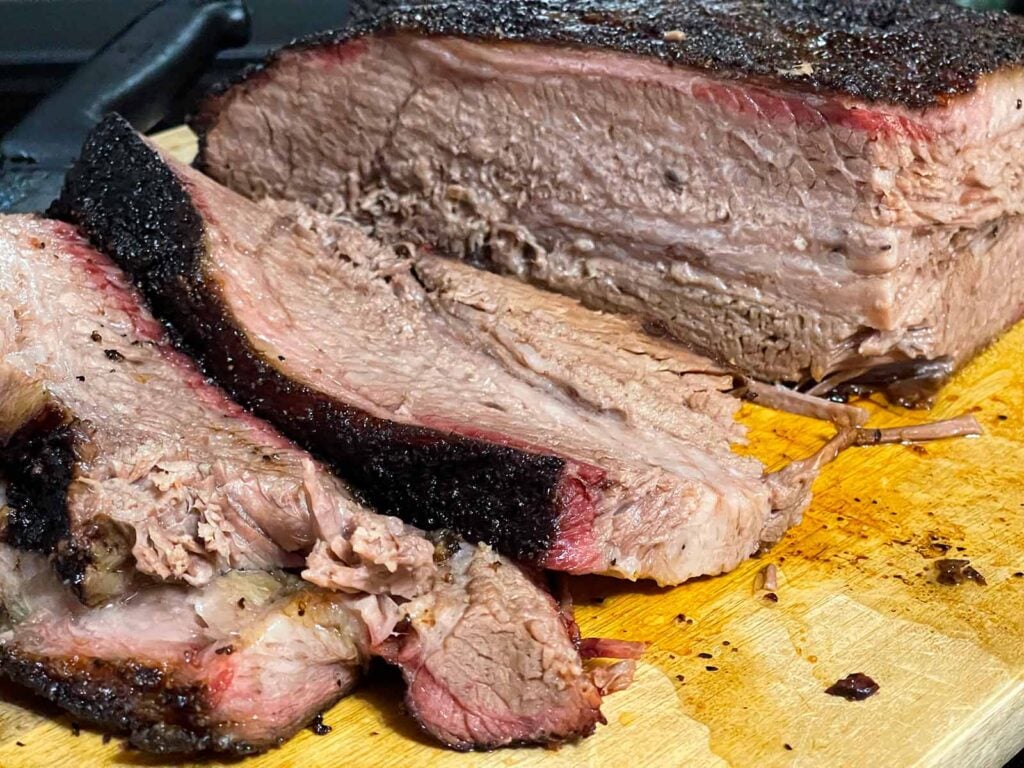
What you’re going to end up with is one of the most mouthwatering, tender, delicious, heavenly pieces of central Texas barbecue meat you have ever had and done. You eat your fill, and if you’re lucky, you’re gonna have some leftovers for some other delicious tasties!
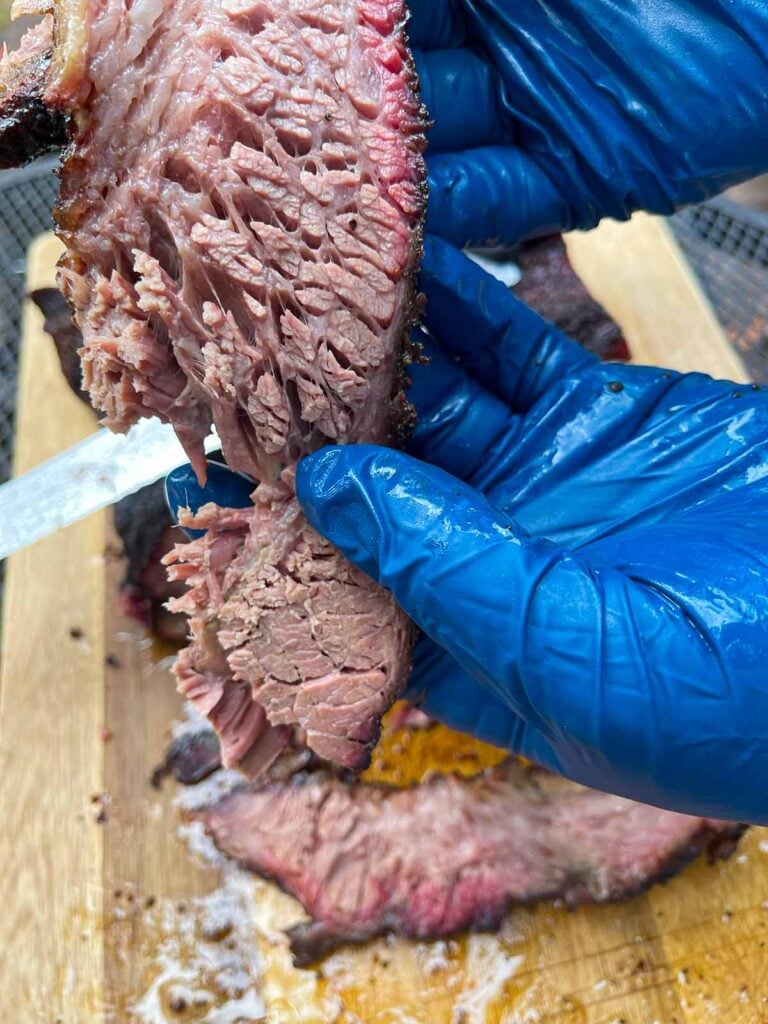
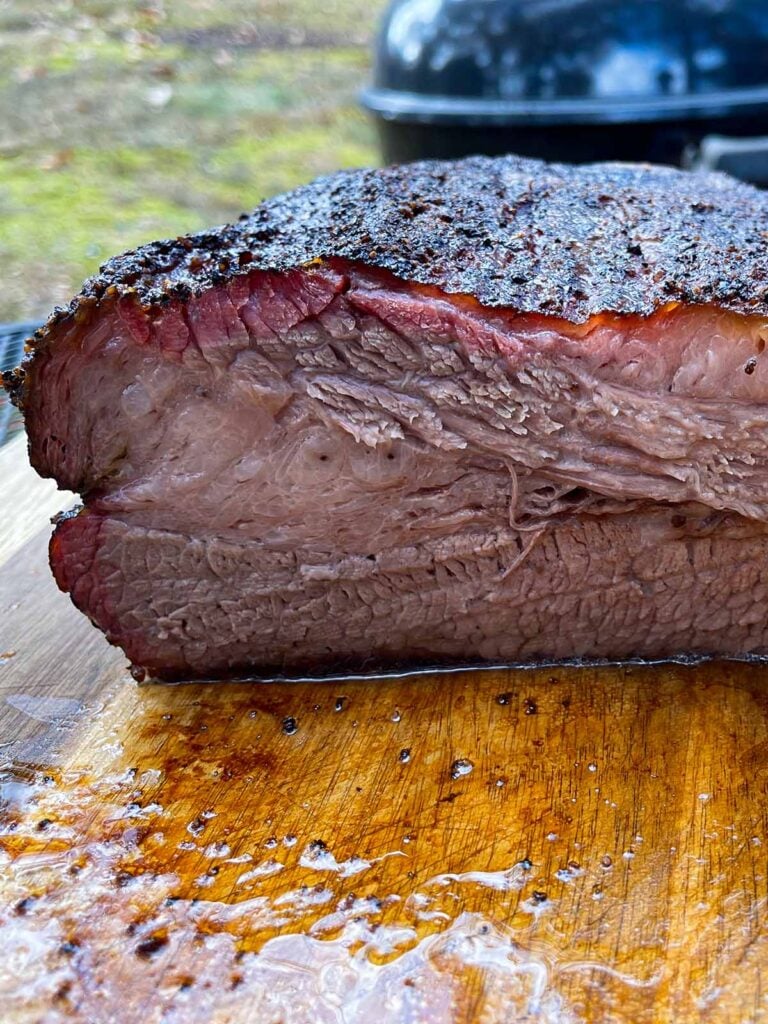
Tips
Here are some things to keep in mind.
Picking the Right Brisket: You’re looking for a packer cut – that perfect mix of fat and lean. Think creamy white fat, not yellow. Marbling? Yes, please! This is what gives our brisket its juicy, mouth-watering goodness.
The Art of Consistency: Temperature control in your smoker is important. We’re aiming for a cool 225 degrees Fahrenheit. And remember, keep that smoker closed! Peeking too often is bad juju.
Wood Matters, Folks!: In the heart of Texas, post oak reigns supreme. But feel free to mix it up with hickory or pecan.
Trimming: Here’s the deal – don’t go overboard with the trimming. A quarter-inch of fat is your golden ticket. It’s like a self-basting feature that keeps everything nice and moist.
Seasoning Simplicity: We’re traditionalists here. A good old rub of kosher salt and coarse black pepper is all you need. A hint of garlic powder? Sure, if you’re feeling adventurous!
Fat Side Up!: Smoking your brisket fat side up lets that fat render down and keep the meat moist and flavorful.
Patience is a Virtue: Good things come to those who wait, and brisket is no exception. Rushing it with high heat is a no-go. Low and slow, my friends.
Temperature is King: We’re looking for that magic number – 203 degrees Fahrenheit.
The Rest is Crucial: After smoking, give your brisket a well-deserved rest, at least an hour to an hour and a half.
Slice Against the Grain: Cutting against the grain isn’t just a saying; it’s the secret to tender slices.
Tools of the Trade: Keep your arsenal ready – a trusty meat thermometer, a sharp knife, and some butcher paper.
Take Notes, Get Better: Every brisket is a learning experience. Jot down what worked and what didn’t. That’s how you perfect your game.
Variations
As this is a Central Texas-style smoked brisket, there aren’t too many variations. But if you want to be creative:
Beer Braised Brisket: After smoking the brisket to 165 degrees Fahrenheit, instead of wrapping it in butcher paper, place it in a deep pan with your favorite dark beer, onions, and garlic. Cover and continue to smoke until it reaches the desired internal temperature. The beer adds a unique flavor while tenderizing the brisket even further. This method also creates a deliciously rich sauce that can be served with the brisket.
Spicy Coffee Rub Brisket: Introduce a bold and rich flavor by adding a coffee-based rub. Combine ground coffee with your standard mix of kosher salt, coarse black pepper, and garlic powder. Add some cayenne pepper and smoked paprika to introduce a spicy kick. The coffee adds a deep, smoky flavor that complements the brisket, while the spicy elements give it an exciting heat that’s perfect for those who enjoy a bit of spice in their BBQ.
For me, I am a purist. For best results, keep it simple.
FAQ’s
In Central Texas style barbecue, post oak is traditionally the wood of choice due to its availability and the subtle, smoky flavor it imparts. However, hickory and pecan are also excellent choices and can be used depending on personal preference or regional availability. Each wood type offers a unique flavor profile, with post oak being more subtle, hickory adding a stronger, sweeter smoke flavor, and pecan offering a milder, nuttier taste.
The general rule of thumb for smoking a brisket is to maintain a low and slow cooking process. Aim to smoke the brisket at a steady temperature of around 225 degrees Fahrenheit. As for timing, expect to smoke the brisket for about 1 to 1.5 hours per pound of meat. However, it’s crucial to cook to temperature, not strictly by time. A brisket is typically done when its internal temperature reaches about 203 degrees Fahrenheit, which is when the connective tissues have broken down sufficiently to make the meat tender and juicy.
When trimming a packer cut brisket, the goal is to remove excess fat and silver skin while preserving enough fat cap (about ¼ inch) to keep the meat moist during smoking. Start by removing the hard, thick fat, known as the deckle, and any large, uneven fat deposits. Trim off the thin, overhanging edges of the meat, which are likely to burn and dry out during the smoking process. The idea is to create a relatively even surface so the brisket cooks uniformly.
Other Amazing Barbecue Recipes
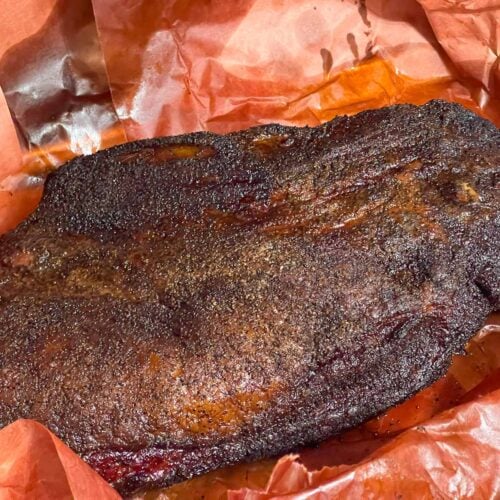
Central Texas Smoked Brisket Recipe
Ingredients
- 1 Beef brisket packer cut
- 1/3 cup Kosher salt
- 1/3 cup Coarse black pepper
- 2 tsp Garlic powder Optional
Instructions
- Remove the brisket from its packaging and pat dry.
- Trim the fat cap to about ¼ inch thickness, remove the deckle (hard fat), and trim off any excessively thin edges.
- Mix equal parts of coarse black pepper and kosher salt, with a touch of garlic powder (if using).
- Rub the mixture generously over the entire brisket.
- Preheat your smoker to 225°F using post oak wood.
- Place the brisket in the smoker, fat side up.
- Smoke until the internal temperature reaches about 165°F.
- Wrap the brisket in unwaxed butcher paper.
- Return to the smoker until the internal temperature of the meat reaches around 203°F.
- Remove the brisket from the smoker.
- Allow it to rest for 90 minutes.
- Unwrap the brisket.
- Slice against the grain, serving slices from both the flat and the point.
